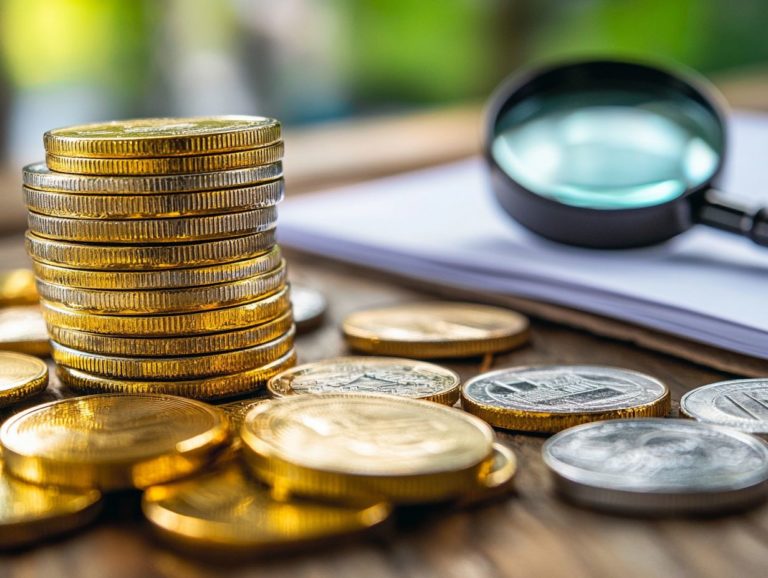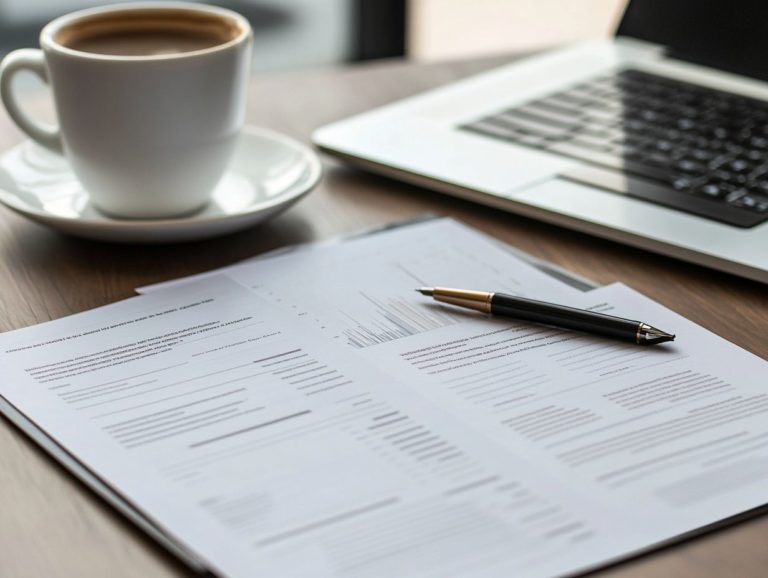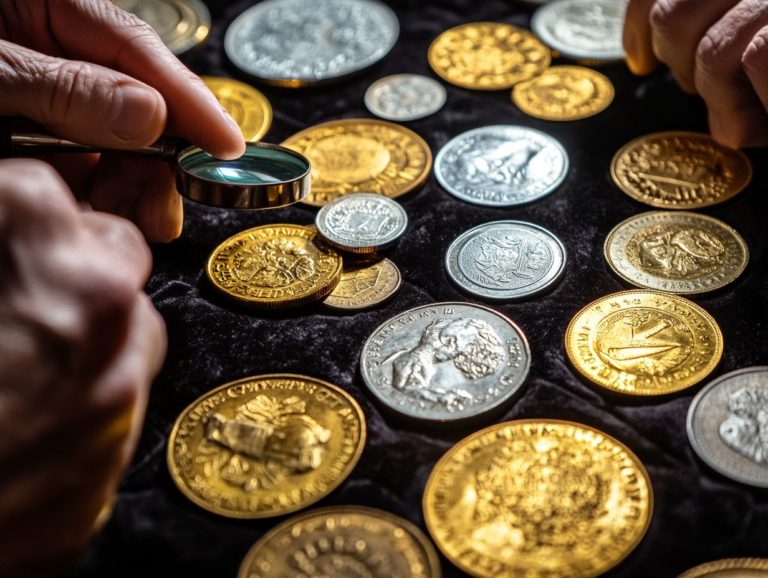How to Research Precious Metals Markets?
Ready to dive into the exciting world of precious metals? The realm of precious metals is captivating and intricate, presenting unique investment opportunities and challenges.
This guide illuminates the complexities of precious metals markets, starting with a clear definition of these valuable assets and key factors that influence their prices.
You’ll discover how to conduct effective research by identifying trustworthy sources and interpreting market data with precision. Essential tools for both technical and fundamental analysis will be introduced, along with savvy strategies for investing wisely in precious metals.
Whether you re a seasoned investor or just stepping into this arena, this overview will equip you with the knowledge you need to navigate the precious metals landscape with confidence.
Contents
- Key Takeaways:
- Understanding Precious Metals Markets
- Researching Precious Metals Markets
- Tools for Analyzing Precious Metals Markets
- Strategies for Investing in Precious Metals
- Long-Term vs. Short-Term Investments
- Diversification and Risk Management
- Frequently Asked Questions
- What are the most common methods for researching precious metals markets?
- How can I stay informed about changes in the precious metals market?
- What factors should I consider when researching precious metals markets?
- Are there any online resources for researching precious metals markets?
- How can I use technical analysis to research precious metals markets?
- What are some potential risks associated with investing in precious metals?
Key Takeaways:

- Familiarize yourself with the basics of precious metals and the factors that impact their markets.
- Utilize reliable sources and interpret market data to make informed decisions.
- Consider using technical and fundamental analysis to assess precious metals markets.
- Develop strategies for investing, such as diversifying your portfolio and managing risk.
Understanding Precious Metals Markets
Understanding precious metals markets requires careful examination of various factors influencing the value and demand for assets like gold, silver, platinum, and palladium, often viewed as safe-haven investments. For those interested, here’s what to know about trade in precious metals.
These metals are not just crucial for diversifying your investment portfolio. They also act as a protective barrier against economic instability and inflation. This makes them a vital part of your financial plan that can safeguard your future, especially in turbulent market conditions.
What are Precious Metals?
Precious metals such as gold, silver, platinum, and palladium are rare treasures with intrinsic value, making them highly sought after for many uses, from exquisite jewelry to essential industrial manufacturing.
These metals possess distinct characteristics that amplify their allure. For example, gold has a radiant luster and remarkable resistance to corrosion, making it the go-to choice for fine jewelry and high-end electronic components.
Silver shines with excellent conductivity, driving demand in industries like photography and solar energy. Platinum and palladium play crucial roles in automotive catalytic converters, working tirelessly to reduce harmful emissions.
However, the market for these metals is anything but static. Changes caused by world events and mining outputs can significantly sway demand, illustrating their importance across various sectors.
Factors Affecting Precious Metals Markets
The precious metals markets are shaped by various factors, including market volatility, inflation, geopolitical events, and the delicate balance between supply and demand, all leading to significant price fluctuations.
As these elements unfold, economic indicators like employment rates and consumer spending provide crucial insights into the broader economic landscape. Central bank policies, particularly shifts in interest rates, add another layer of complexity to this intricate web.
When central banks tighten monetary policy, borrowing costs rise, often reducing spending and investment, which diminishes demand for metals. During periods of high inflation, investors may gravitate toward precious metals as a hedge.
Gaining a deep understanding of how these factors interact equips you with a clearer perspective on current market dynamics and anticipated trends.
Researching Precious Metals Markets
Researching precious metals markets demands a sophisticated approach that intricately weaves together market insights, technical analysis, and tracking precious metal prices with fundamental analysis.
This comprehensive strategy enables you to assess price trends and delve into historical data, ensuring a well-rounded understanding of the market dynamics at play.
Identifying Reliable Sources
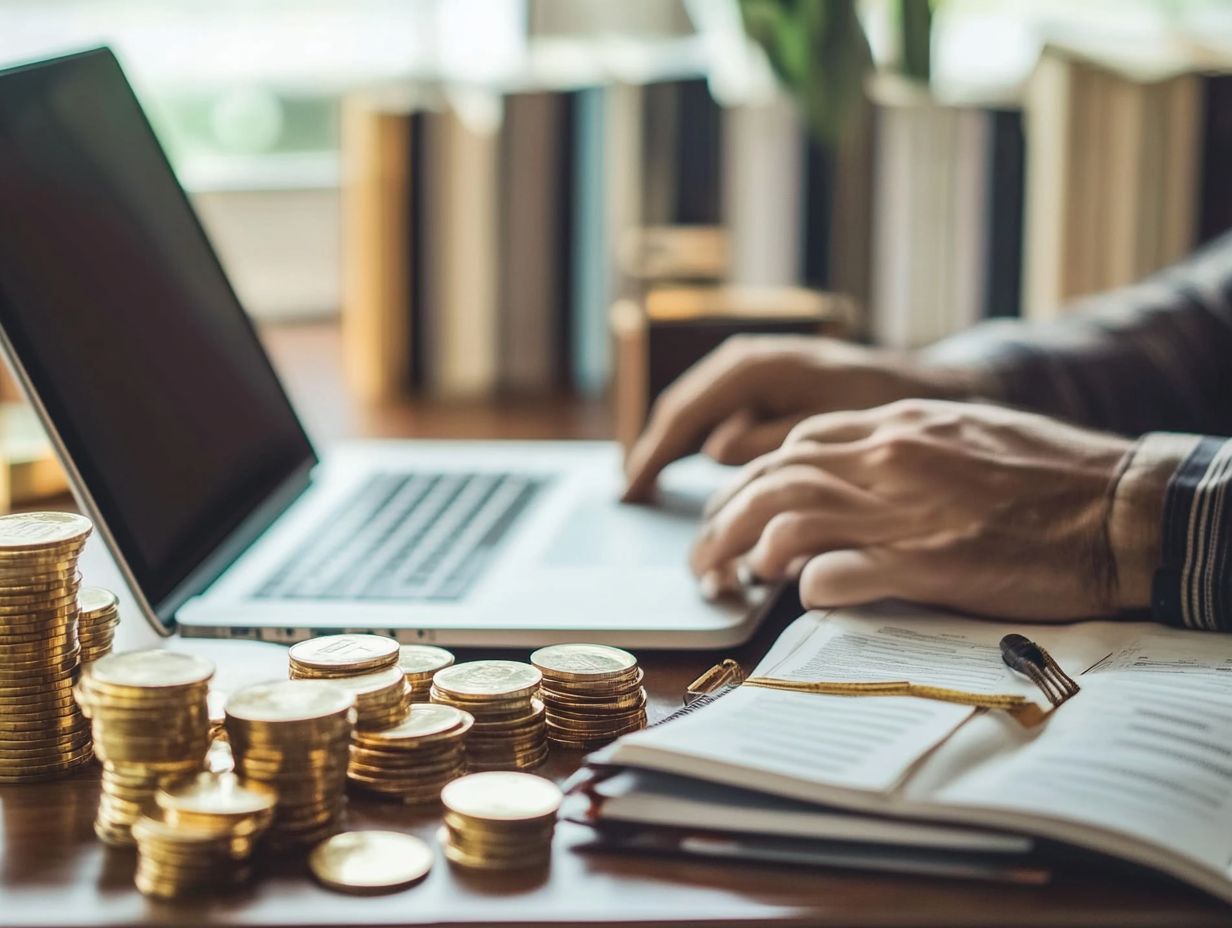
Identifying reliable sources for precious metals market information requires discerning trustworthy commodity ETFs, mutual funds, and mining companies that provide accurate insights on market conditions and investor sentiment.
To evaluate the credibility of these sources, examine key elements such as the reputation of financial analysts, their update frequency, and historical accuracy in forecasting trends.
Industry reports are valuable, offering in-depth analyses and projections that illuminate the broader market landscape for investors.
Transparency is essential, providing a clear view of the underlying factors that influence performance and investor sentiment. By considering the integrity of the information and the motivations behind its dissemination, you can make informed decisions in a fluctuating market.
Interpreting Market Data
Interpreting market data is vital when assessing precious metals. It involves analyzing price trends, understanding technical indicators, and using sentiment analysis to anticipate future price movements.
To navigate this intricate landscape, employ techniques such as examining charts and graphs that illustrate historical price behavior. This will help you identify recurring patterns.
Statistical tools provide a framework for evaluating volatility and market dynamics. By combining technical analysis which focuses on price action and volume with sentiment analysis, you create a holistic approach.
This combination enhances your understanding of potential movements and enables you to make decisions based on both numerical data and market sentiment.
Tools for Analyzing Precious Metals Markets
Utilize a variety of tools to analyze precious metals markets, focusing on both technical and fundamental analysis.
This dual approach helps you develop robust investment strategies while gaining a deeper understanding of market trends.
Technical Analysis
Technical analysis is a powerful method for predicting future price movements of precious metals. It uses tools like moving averages (which smooth out price fluctuations), the relative strength index (RSI, a tool that compares recent gains to losses), and MACD (which indicates momentum) to dissect market trends.
By analyzing historical data and price charts, you can uncover patterns and correlations that shape your trading strategies.
Mastering these indicators allows you to make informed choices that align with your risk tolerance and market outlook, positioning yourself for success in the ever-evolving landscape of precious metals trading.
Fundamental Analysis
Fundamental analysis focuses on evaluating essential factors that influence precious metals, including economic indicators, supply chain dynamics, and demand trends to guide investment decisions.
By exploring these components, you gain insights into how various market conditions impact price trends. For example, inflation rates can increase interest in precious metals as a hedge, while geopolitical tensions may drive demand due to their perceived safety.
Fluctuations in mining output can significantly affect supply, which in turn influences market availability and pricing. Understanding these intricate interconnections enables you to make informed choices rooted in the broader economic landscape, enhancing your strategies in a constantly changing market.
Strategies for Investing in Precious Metals
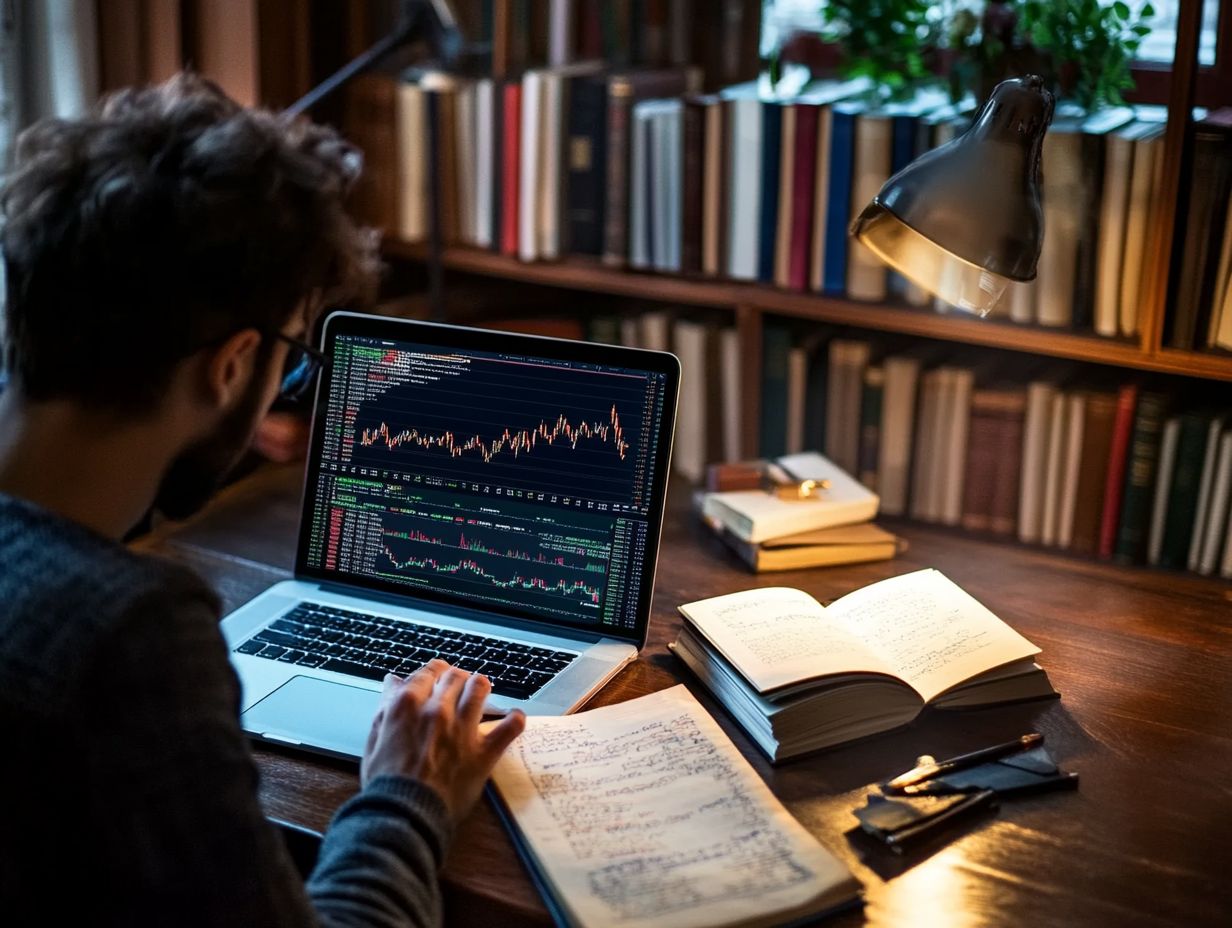
Your strategies for investing in precious metals can vary greatly, incorporating both long-term and short-term investments. This approach is essential for diversification, helping to mitigate risk during financial crises.
Don t miss out on the chance to enhance your investment portfolio. Start analyzing market data and developing your strategies today!
Long-Term vs. Short-Term Investments
You must carefully weigh the differences between long-term and short-term investments in precious metals. Each approach can lead to distinct outcomes influenced by market conditions and price fluctuations.
Long-term investments in precious metals provide stability. This helps you weather the market’s inherent volatility over time.
This strategy can be especially advantageous during periods of economic uncertainty. A diversified investment portfolio helps reduce risk.
On the other hand, short-term investments might attract you if you re looking for quick returns. However, they come with the challenge of navigating unpredictable price swings and potentially incurring higher transaction costs.
Ultimately, understanding these different strategies helps you align your choices with your financial goals and risk tolerance. This knowledge paves the way for more informed decisions.
Diversification and Risk Management
Diversification and effective risk management are crucial strategies for you as an investor in precious metals. They help stabilize your investment portfolio and provide a cushion against economic instability.
By diversifying your investments across various assets like gold, silver, and platinum, you can reduce potential losses during market downturns. These metals typically do not move in the same way as traditional stocks, which is a smart move.
In times of economic uncertainty, precious metals act as a safe haven. They often maintain their value when other investments suffer.
Recognizing that these safe assets offer not only security but also intrinsic value can significantly improve the resilience of your portfolio. They serve as a safeguard against inflation and currency fluctuations, both of which can erode your purchasing power.
Investing wisely in precious metals is not just about security; it’s about strengthening your financial future.
Frequently Asked Questions
What are the most common methods for researching precious metals markets?
The most common methods for researching precious metals markets include analyzing market trends, tracking current events and economic indicators, studying supply and demand factors, and monitoring the importance of research in precious metal investing to evaluate the performance of specific metals.
How can I stay informed about changes in the precious metals market?

There are several ways to stay informed about changes in the precious metals market. You can regularly read reputable financial news sources, follow industry experts and analysts, and subscribe to market updates and newsletters.
What factors should I consider when researching precious metals markets?
When researching precious metals markets, it’s important to consider factors such as global economic conditions, geopolitical events, supply and demand, inflation rates, and currency fluctuations. If you’re interested in learning more about how to start investing in precious metals, these elements are crucial to your strategy.
Are there any online resources for researching precious metals markets?
Yes, many online resources are available for researching precious metals markets. These include financial news websites, industry blogs, and criteria for precious metals investment, as well as educational resources from reputable organizations.
How can I use technical analysis to research precious metals markets?
Technical analysis involves studying past market data and using chart patterns and indicators to predict future price movements. This method can be applied to research precious metals markets by analyzing historical price trends and identifying potential patterns and trends.
What are some potential risks associated with investing in precious metals?
Like any investment, there are risks associated with investing in precious metals. These include fluctuating market prices, economic and political instability, and the potential for fraud or scams. It’s important to thoroughly research and understand these risks before making any investment decisions.


